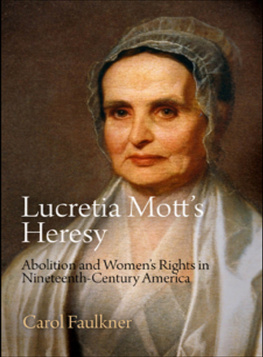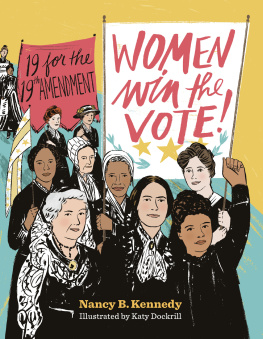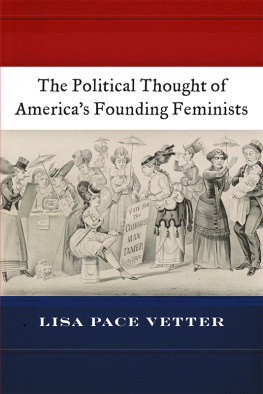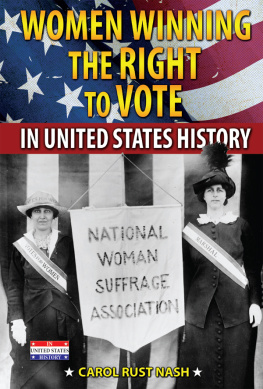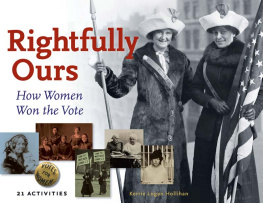ACKNOWLEDGMENTS
The first spark for this book began in Kathryn Kish Sklars amazing course on American womens history at Binghamton University, as Kitty discussed the career of Lucretia Mott and asked, Can you believe there is no scholarly biography of Mott? Beverly Wilson Palmer offered further inspiration and guidance when I worked as an editing fellow on The Selected Letters of Lucretia Coffin Mott. I am grateful to have such incredible mentors.
Since those early days, many people have offered assistance and encouragement. At SUNY Geneseo, President Chris Dahl, Provost Kate Conway-Turner, and Chair Jim Williams enabled a research leave at a crucial stage in this project. I am also grateful to Michael Oberg, who provided timely and essential assistance on the history of the Seneca Indians, and Emilye Crosby, who read the entire manuscript and came up with the title. When I moved to Syracuse University, my new colleagues Subho Basu, David Bennett, Susan Branson, Albrecht Diem, Michael Ebner, Paul Hagenloh, Samantha Herrick, Amy Kallander, George Kallander, Norman Kutcher, Chris Kyle, Elisabeth Lasch-Quinn, Dennis Romano, Roger Sharp, David Stam, Scott Strickland, Junko Takeda, and Margaret Susan Thompson welcomed me and this project. I owe special thanks to Dean Mitchel Wallerstein, Associate Dean Michael Wasylenko, and Craige Champion. I rely heavily on the excellent History Department staff: Patti Blincoe, Fran Bockus, and Patti Bohrer.
I appreciated the opportunity to research and write at some wonderful institutions. At Friends Historical Library, I benefited from a Margaret W. Moore and John M. Moore Research Fellowship. Curator Chris Densmore is a model historian and great ally. The FHL staff, including Barbara Addison, Charlotte Blandford, Susanna Morikawa, and Patricia ODonnell, answered my questions with patience and enthusiasm. I am grateful for a Library Company/Historical Society of Pennsylvania research fellowship, and the advice and assistance of Tammy Gaskell, James Green, Nicole Joniec, and Phil Lapsansky. I spent an enjoyable and productive semester at the Gilder Lehrman Center for the Study of Slavery, Resistance, and Abolition at Yale University, with its great director David Blight, assistant director Dana Schaffer, and education director Tom Thurston. The librarians and staff at Syracuse University Library, especially Charlotte Hess, Charles Russo, Suzanne Thorin, Lydia Wasylenko, and Mark Weimer, offer fantastic support for faculty research and teaching. Finally, I am indebted to Diana Carey at the Schlesinger Library, Elaine Grublin at the Massachusetts Historical Society, Mary Huth at the University of Rochester Library, and the staff at the Nantucket Historical Association, especially Marie Henke and Elizabeth Oldham.
Many fellow scholars and biographers contributed their insight and expertise. At the Schlesinger Librarys Summer Seminar Writing Past Lives: Biography as History, Nancy Cott, Lori Ginzberg, Megan Marshall, and all the participants gave me valuable feedback. The members of the Rochester-Area U.S. Historians (RUSH) group read drafts of several chapters, and I am grateful to Jenny Lloyd, Dorinda Outram, Alison Parker, and other regulars for their close readings. Two research assistants, Alexandra Elias and Nicole Sanford, helped me with other projects so I could finish this one. It was a pleasure to meet Sherry Penney and Jim Livingston, scholars and descendents of Martha Coffin Wright. I also want to thank Bonnie Anderson, Margaret Hope Bacon, Lyn Blackwell, Lyn Blanchfield, Kate Culkin, Tom Dublin, Laura Edwards, Claudette Fillard, Ann Gordon, Nancy Hewitt, Kathi Kern, Michelle Kuhl, Linda Janke, Bonnie Laughlin-Schultz, Roderick McDonald, Richard Newman, Kristen Tegtmeier Oertel, Franoise Orazi, Jeff Pickron, Michael Pierson, Hlne Quanquin, Stacey Robertson, Marcia Robinson, Leslie Schwalm, Connie Shemo, James Brewer Stewart, Lisa Tetrault, members of the Upstate New York Womens History Organization, Judith Wellman, Dot Willsey and the National Abolition Hall of Fame, Victoria Wolcott, and Jean Fagan Yellin for their support at various stages of the project.
I am thrilled to be publishing another book with the University of Pennsylvania Press. Peter Agree was an enthusiastic supporter of this biography from the beginning, and I am thankful for his kindness and advice. Alison Anderson, Chris Bell, Robert Lockhart, Julia Rose Roberts, and Mariellen Smith have helped this book along in many ways. Also, I deeply appreciate the thorough review of the manuscript by Lori Ginzberg and the anonymous reader. Their wise suggestions greatly improved the book. Thanks also to Kathryn Simmons of Twin Oaks Indexing for her skill and speed.
I could not have written this book without the help of friends and family. Joanne Landy and members of the X-biking class at the JCC offered laughs and a much-needed workout. I enjoyed good conversation and playdates with Annie and Mike Brandt and family, and Lyn Blanchfield and Paul Batkin and family. Andy and Amy Lutz welcomed me into their home during a research trip to Philadelphia. I also appreciate the continued hospitality of my father-in-law Robert Baer Cohen in Philadelphia. My parents, David and Joanne Faulkner, provide love and a place to stay in New Haven. Unsurprisingly, they are extraordinary babysitters as well. My family, especially my sister Jill, my brother Jim, my Aunt Joan and Uncle Walt, are always interested in what Im doing. My joyful daughter Mae deserves credit for dragging me away from the computer to play. My greatest love and appreciation is for Andrew Wender Cohen. I am extremely lucky to have his companionship, humor, imagination, and support.
CHAPTER 1
Nantucket
IN 1855, WHEN ELIZABETH CADY STANTON wanted information for a proposed history of the womens rights movement, she asked Lucretia Mott about Nantucket women. Born in 1793 to Anna Folger and Thomas Coffin, Lucretia spent the first eleven years of her life on Nantucket Island, approximately thirty miles off the coast of Massachusetts. She always considered herself an islander, recalling the social ties & happy realizations of Nantucket society; as an adult, Lucretia attempted to recreate this community bound by kinship, religion, and politics. Idealizing Motts upbringing, Stanton viewed Lucretias Nantucket childhood as central to her public career as an abolitionist and womens rights activist.
In her typical self-effacing manner, Mott wrote Stanton that As to Nantucket women, there are no great things to tell. But she proceeded to recount the history of women on the island, beginning with Mary Starbuck, an ancestor who almost single-handedly converted the islands white residents to the Religious Society of Friends in 1702. Though mid-nineteenth-century American culture dictated that women serve as the moral counterpart for the male world of business and politics, Lucretia noted that on Nantucket, education & intellectual culture have been for years equal for girls & boysso that their women are prepared to be the companions of men in every senseand their social circles are never divided. Recalling the experiences of her mother and other wives of sailors, Lucretia stated, During the absence of their husbands, Nantucket women have been compelled to transact business, often going to Boston to procure supplies of goodsexchanging for oil, candles, whalebone&.cThis has made them adept in tradeThey have kept their own accounts, & indeed acted the part of men. Like Stanton, Lucretia believed these early influences helped her defy the limited domestic and fashionable lives of most middle-class Victorian women. Raised with the communal memory of Mary Starbuck, and the daily observance of Anna Coffins business acumen, at a young age Lucretia rejected the idea that women were spiritually or intellectually inferior to men.
The material and religious conditions of eighteenth-century Nantucket also shaped Lucretias views of individual liberty, religious freedom, and the most pressing problem facing the new nation, slavery. Although Quakerism was the dominant religion on the island, the Society of Friends nevertheless provided a framework in which to critique ecclesiastical authority and established religion. Like other seaports, Nantucket was a cosmopolitan society; its boats sailed across the Atlantic and Pacific oceans, trading commodities and consumer goods and facilitating the movement of people and ideas. White settlers on the island used Native American labor for their first ventures in whaling; the industry later turned to free African Americans to staff its boats. The Coffin familys residence on late eighteenth-century Nantucket exposed Lucretia to a range of powerful intellectual currents, from Quaker radicalism to free trade to enlightenment reform. It also introduced her to a set of social questions, most important the place of non-white Americans in the new nation.
Next page
